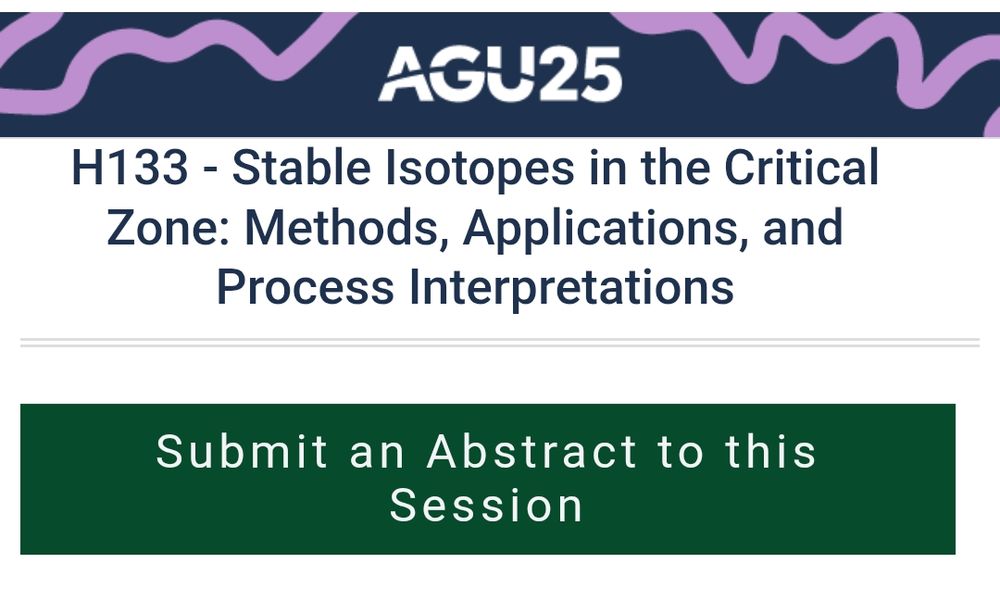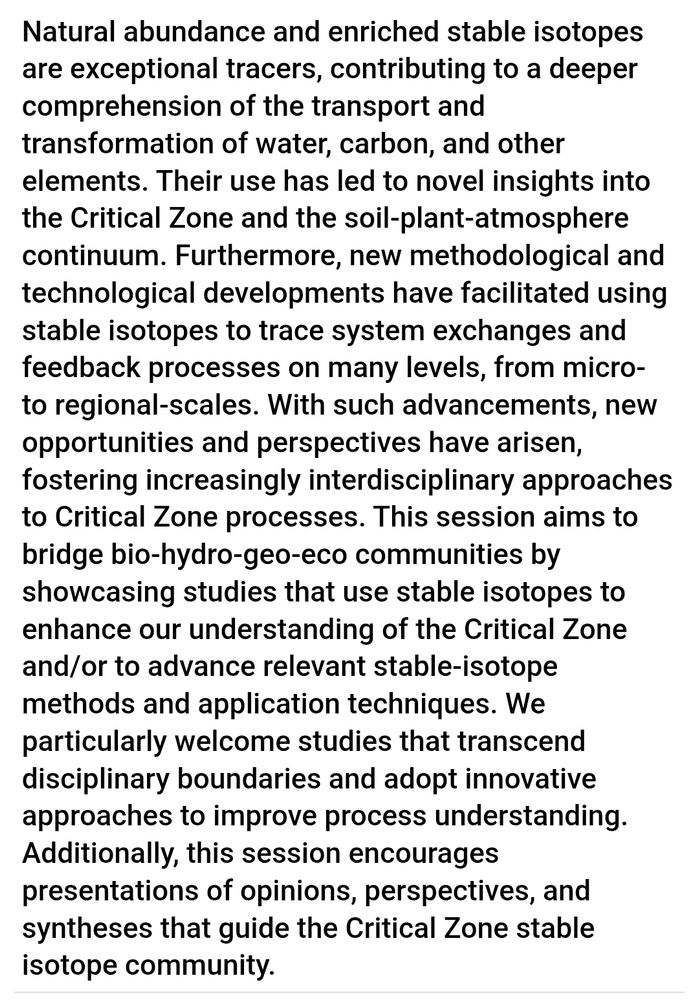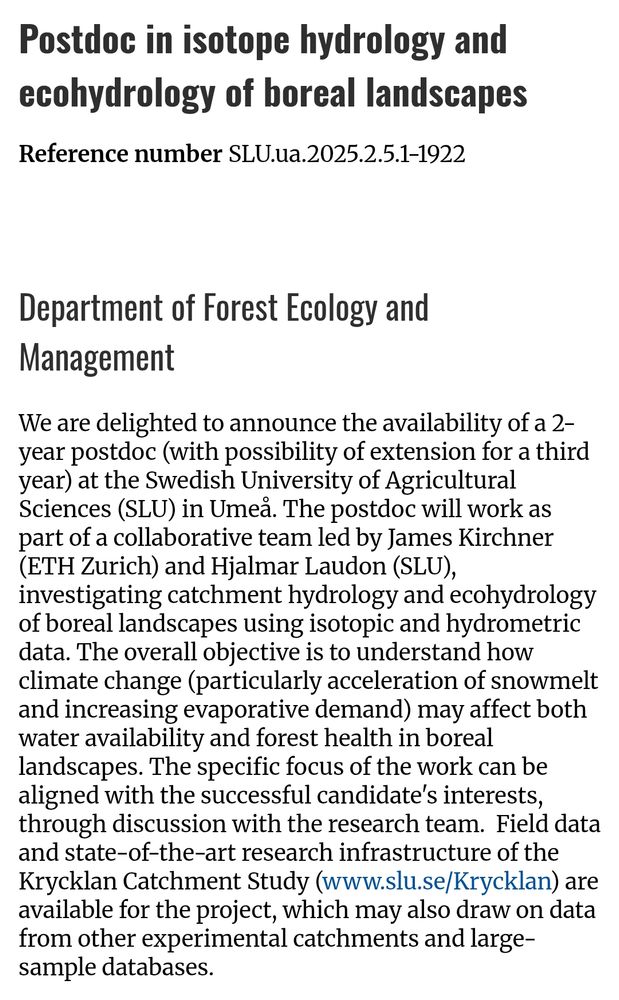
Matthias Sprenger
@matthiasprenger.bsky.social
Hydrologist working on catchment hydrology, ecohydrology, stable isotopes, and Critical Zone research, https://matthiassprenger.weebly.com/
PF was more likely where antecedent soil moisture variability was low, which was found to be more important than the mean antecedent soil moisture conditions.
PF also generally increased with higher Net Primary Productivity (NPP) & in more humid climates (macropore formation through root growth).
PF also generally increased with higher Net Primary Productivity (NPP) & in more humid climates (macropore formation through root growth).

October 10, 2025 at 11:47 AM
PF was more likely where antecedent soil moisture variability was low, which was found to be more important than the mean antecedent soil moisture conditions.
PF also generally increased with higher Net Primary Productivity (NPP) & in more humid climates (macropore formation through root growth).
PF also generally increased with higher Net Primary Productivity (NPP) & in more humid climates (macropore formation through root growth).
We identified the primary drivers using Random Forest models. Rainfall intensity, soil texture, & antecedent soil moisture emerged as critical factors:
PF likelihood steeply increased between 5 & 12 mm/h, demonstrating a critical threshold-like behavior.
PF was more likely with higher clay content.
PF likelihood steeply increased between 5 & 12 mm/h, demonstrating a critical threshold-like behavior.
PF was more likely with higher clay content.

October 10, 2025 at 11:47 AM
We identified the primary drivers using Random Forest models. Rainfall intensity, soil texture, & antecedent soil moisture emerged as critical factors:
PF likelihood steeply increased between 5 & 12 mm/h, demonstrating a critical threshold-like behavior.
PF was more likely with higher clay content.
PF likelihood steeply increased between 5 & 12 mm/h, demonstrating a critical threshold-like behavior.
PF was more likely with higher clay content.
We used data from approximately 1500 sensors at 40 NEON sites across the USA. Our findings show that PF is ubiquitous and occurred at all sites studied. Specifically, sites experienced PF in up to 60% of all rainfall events >2 mm. This confirms PF is a pervasive feature of hydrological systems.

October 10, 2025 at 11:47 AM
We used data from approximately 1500 sensors at 40 NEON sites across the USA. Our findings show that PF is ubiquitous and occurred at all sites studied. Specifically, sites experienced PF in up to 60% of all rainfall events >2 mm. This confirms PF is a pervasive feature of hydrological systems.
PF describes the rapid movement of water that bypasses a large fraction of the soil matrix. Thus, PF is critically influencing groundwater recharge and contaminant transport. In this study, we used the velocity threshold method and the non sequential response method doi.org/10.1002/vzj2...

October 10, 2025 at 11:47 AM
PF describes the rapid movement of water that bypasses a large fraction of the soil matrix. Thus, PF is critically influencing groundwater recharge and contaminant transport. In this study, we used the velocity threshold method and the non sequential response method doi.org/10.1002/vzj2...
As a new prof, I am exploring approachable ways to teach about catchment hydrology modeling. A lack of students'coding skills are limiting the opportunities. Google Gemini with Canvas has the potential to code simulators based on text input. See screen recording of quick example. What do you think?
October 7, 2025 at 1:43 PM
As a new prof, I am exploring approachable ways to teach about catchment hydrology modeling. A lack of students'coding skills are limiting the opportunities. Google Gemini with Canvas has the potential to code simulators based on text input. See screen recording of quick example. What do you think?
As I take with students our first water samples for isotope analyses in North Carolinian catchments I think of "a magic dwells in each beginning". It's fun to have a study site nearby and add to ongoing NCSU and USFS research.
October 4, 2025 at 12:29 AM
As I take with students our first water samples for isotope analyses in North Carolinian catchments I think of "a magic dwells in each beginning". It's fun to have a study site nearby and add to ongoing NCSU and USFS research.
These models have led to important discoveries, like the "old water paradox"—stormflow is often dominated by older, stored water, not just the recent rainfall! This reveals the relevance of catchment storage.

October 1, 2025 at 5:06 PM
These models have led to important discoveries, like the "old water paradox"—stormflow is often dominated by older, stored water, not just the recent rainfall! This reveals the relevance of catchment storage.
How do we track water from a raindrop to an aquifer? Tracer-aided mixing models use naturally occurring markers to identify water flow paths and quantify the contributions of different sources (like rain vs. groundwater) to streamflow.

October 1, 2025 at 5:06 PM
How do we track water from a raindrop to an aquifer? Tracer-aided mixing models use naturally occurring markers to identify water flow paths and quantify the contributions of different sources (like rain vs. groundwater) to streamflow.
What is the Critical Zone (CZ)? 🌍 It's Earth's living skin—a dynamic interface where air, water, soil, plants, and rocks interact. Understanding water's journey through the CZ is vital for safeguarding our water resources and ecosystems.

October 1, 2025 at 5:06 PM
What is the Critical Zone (CZ)? 🌍 It's Earth's living skin—a dynamic interface where air, water, soil, plants, and rocks interact. Understanding water's journey through the CZ is vital for safeguarding our water resources and ecosystems.
Congrats to Jeff McDonnell (Horton Medal) & Chris Soulsby (Langbein Lecture)! 2 highly influential catchment hydrologists get awarded @ #AGU25. Well deserved, because their stable isotope & transit times work had a huge impact! I personally learnt so much from them. Photo from a 2016 project meeting

September 26, 2025 at 6:58 PM
Congrats to Jeff McDonnell (Horton Medal) & Chris Soulsby (Langbein Lecture)! 2 highly influential catchment hydrologists get awarded @ #AGU25. Well deserved, because their stable isotope & transit times work had a huge impact! I personally learnt so much from them. Photo from a 2016 project meeting
As the upper 60 cm of soil dries, the aspen shift their uptake to deeper depths )(=compensatory uptake), tapping into stored snowmelt. When monsoonal rain happens, the uptake changes to the top soil. These dynamics were seen using natural isotope abundance and confirmed with deuterium sprinkling.

August 21, 2025 at 2:13 PM
As the upper 60 cm of soil dries, the aspen shift their uptake to deeper depths )(=compensatory uptake), tapping into stored snowmelt. When monsoonal rain happens, the uptake changes to the top soil. These dynamics were seen using natural isotope abundance and confirmed with deuterium sprinkling.
Our in situ set up, developed at the University of Freiburg by Seeger&Weiler, allows to get daily isotopic information that we can use to infer the water uptake depths for the studied aspen and spruce trees via MixSIAR mixing models. We see short-term variation driven by water availability.

August 21, 2025 at 2:13 PM
Our in situ set up, developed at the University of Freiburg by Seeger&Weiler, allows to get daily isotopic information that we can use to infer the water uptake depths for the studied aspen and spruce trees via MixSIAR mixing models. We see short-term variation driven by water availability.
What a warm welcome at NC State by Ms and Mr Wuf! Looking forward to new opportunities for research and teaching as a hydrology professor and getting to know my new colleagues at the department of forestry and environmental resources.

August 14, 2025 at 6:34 PM
What a warm welcome at NC State by Ms and Mr Wuf! Looking forward to new opportunities for research and teaching as a hydrology professor and getting to know my new colleagues at the department of forestry and environmental resources.
Reminds me of this sketch by @clysy.bsky.social

August 7, 2025 at 1:32 PM
Reminds me of this sketch by @clysy.bsky.social
The US department that used to be proud of 118 affiliated iconic and legendary Nobel Laureates, now apparently believes that coal is the icon and legend.

August 4, 2025 at 1:37 AM
The US department that used to be proud of 118 affiliated iconic and legendary Nobel Laureates, now apparently believes that coal is the icon and legend.
Our primary convener @davidguzzy.bsky.social made this nice flyer for the session. We are happy to have the @segura-lab.bsky.social joining the session as an invited speaker! You all have still 9 days to submit your abstracts on "Stable Isotopes in the Critical Zone": agu.confex.com/agu/agu25/pr...

July 21, 2025 at 8:11 PM
Our primary convener @davidguzzy.bsky.social made this nice flyer for the session. We are happy to have the @segura-lab.bsky.social joining the session as an invited speaker! You all have still 9 days to submit your abstracts on "Stable Isotopes in the Critical Zone": agu.confex.com/agu/agu25/pr...
We invite again the stable isotope community to present their research at our long-standing #AGU25 session on "Stable Isotopes in the Critical Zone: Methods, Applications, and Process Interpretations"
agu.confex.com/agu/agu25/pr...
The deadline is by the end of July.
agu.confex.com/agu/agu25/pr...
The deadline is by the end of July.


July 15, 2025 at 11:35 AM
We invite again the stable isotope community to present their research at our long-standing #AGU25 session on "Stable Isotopes in the Critical Zone: Methods, Applications, and Process Interpretations"
agu.confex.com/agu/agu25/pr...
The deadline is by the end of July.
agu.confex.com/agu/agu25/pr...
The deadline is by the end of July.
Tourists that crossed our paths, while we were measuring and sampling the subalpine forests and meadows were often interested in our work and it felt good to hear "Thanks for your important work!" or "Good luck, I hope you keep the funding". However, a personal highlight was petting a toddler Yak!



July 10, 2025 at 12:52 PM
Tourists that crossed our paths, while we were measuring and sampling the subalpine forests and meadows were often interested in our work and it felt good to hear "Thanks for your important work!" or "Good luck, I hope you keep the funding". However, a personal highlight was petting a toddler Yak!
Field work is hitting differently this year: my last trip to the East River as LBL scientist & funding for continuation of the Watershed SFA's work is uncertain. I enjoyed contributing to a great team of RMBL & LBL scientists + many highly motivated students as part of the CHESS campaign!


July 10, 2025 at 12:52 PM
Field work is hitting differently this year: my last trip to the East River as LBL scientist & funding for continuation of the Watershed SFA's work is uncertain. I enjoyed contributing to a great team of RMBL & LBL scientists + many highly motivated students as part of the CHESS campaign!
I'm excited to share that I will be joining NC State's Department of Forestry and Environmental Resources as an assistant professor in hydrology by mid August. I'll be building a lab to continue working on process understanding of forested catchments and isotope hydrology.

June 19, 2025 at 4:55 PM
I'm excited to share that I will be joining NC State's Department of Forestry and Environmental Resources as an assistant professor in hydrology by mid August. I'll be building a lab to continue working on process understanding of forested catchments and isotope hydrology.
This sounds like a great Postdoc opportunity working on isotope hydrology and ecohydrology of boreal landscapes with Hjalmar Laudon and Jim Kirchner at SLU
www.slu.se/en/about-slu...
www.slu.se/en/about-slu...


May 27, 2025 at 12:42 PM
This sounds like a great Postdoc opportunity working on isotope hydrology and ecohydrology of boreal landscapes with Hjalmar Laudon and Jim Kirchner at SLU
www.slu.se/en/about-slu...
www.slu.se/en/about-slu...
If you want to start investigating preferential flow via soil moisture time series, you can start thinking about the measurement design and analyses using the flow chart we prepared to bring together the minimum data requirements for each of the six methods.

April 11, 2025 at 7:16 PM
If you want to start investigating preferential flow via soil moisture time series, you can start thinking about the measurement design and analyses using the flow chart we prepared to bring together the minimum data requirements for each of the six methods.
Most studies limit their analyses to the upper 50 cm of soil profiles and some extend their analyses down to 100 cm (often max. arm length). Any soil moisture observations deeper than 1 m are rare.

April 11, 2025 at 7:16 PM
Most studies limit their analyses to the upper 50 cm of soil profiles and some extend their analyses down to 100 cm (often max. arm length). Any soil moisture observations deeper than 1 m are rare.
Most studies investigating preferential flow use high frequency soil moisture measurements, which is great, because preferential flow is expected to occur on very small time scales. Unfortunately, individual studies tend to rely on relatively few instrumented sites -- most often around 10 sites.

April 11, 2025 at 7:16 PM
Most studies investigating preferential flow use high frequency soil moisture measurements, which is great, because preferential flow is expected to occur on very small time scales. Unfortunately, individual studies tend to rely on relatively few instrumented sites -- most often around 10 sites.


